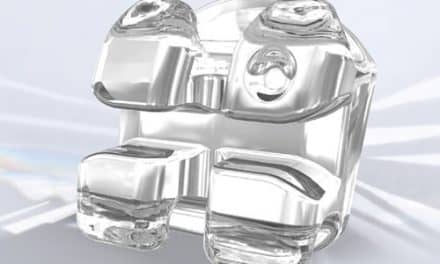by Tyler H. Jolley, DMD
A better look at ceramic brackets
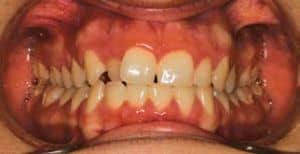
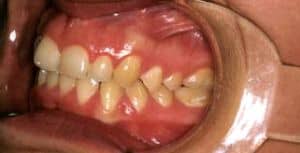
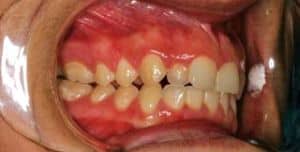
Initial: The patient presented with Class II molar and canine on the right side and Class 1 molar and canine on the left side. The upper midline was to the left.
Ceramic brackets have been around since the early 1980s. A lot of taboos have been linked to them, some of which have included claims that they make treatment slower and that they can ruin enamel on debonding. Today, due to advances in bracket material and design, these concerns are a thing of the past. Clear braces are a good option for any age of patient.
There are many different kinds of clear brackets, such as monocrystalline (transparent), polycrystalline (opaque), and a hybrid of metal and porcelain that has a self-ligation feature. I have used a variety of clear brackets in my practice. I have cases with polycrystalline brackets with a metal slot, and I have cases that use monocrystalline without metal slots. I have placed and debonded thousands of different types of clear brackets. This article discusses what we have learned in the purely clinical setting of our practice.
Types of Brackets
Monocrystalline brackets are very clear. When I say “very clear,” I mean H2O clear. These brackets are the most aesthetic. They generally don’t have a metal slot. They don’t stain. Monocrystalline goes through a thermal polishing process that eliminates the peaks and valleys at a microscopic level. The result is that monocrystalline is stronger than polycrystalline. You can have a smaller bracket size with a drag coefficient almost the same as a metal slot.
Debonding, however, can be tricky. Using a specialized plier (it looks like a modified pin ligature cutter) makes debonding easier. Even with this instrument, though, some of the bracket base can be left behind, and you will need the trusty handpiece with a coarse diamond to remove this remnant. These do not stain.
Polycrystalline brackets (aka porcelain ceramic brackets) are more opaque and tooth-colored. The brackets are relatively rough, so some companies use a metal slot to overcome frictional restrictions. The metal slot can be gold or grey in color. The purpose of the insert is to speed up treatment, but I haven’t seen any difference. In fact, in my hands, using monocrystalline brackets that have a very smooth slot seems to be a better option.
Polycrystalline fractures to a point then stops (like when a windshield gets cracked). This means that the brackets don’t shatter when unlikely stress patterns are placed on them if patients have parafunctional habits or choose to eat tough meats or hard breads.
In my experience, polycrystalline brackets can draw up darker-colored liquids such as red wine, coffee, and sports drinks, and become less white as treatment goes along. I have had only one patient manage to keep this type of bracket as clear as when she started treatment. I tell my patients to drink through a straw or simply brush after drinking or eating anything that might stain.
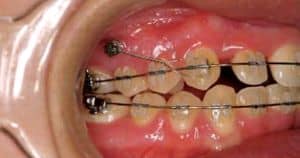
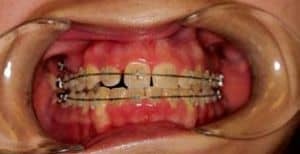
Progress: We placed a TAD on the upper right to achieve en masse midline shift to the right. The patient does not have to use elastics to complete this type of tooth movement.
Clinical Considerations
All the types of clear brackets work excellently with TADs. If you are trying to create indirect anchorage or direct anchorage, it doesn’t matter which clear bracket system you use. When using TADs with your clear bracket system of choice, you should take into consideration the adverse side effects you will have with the pulling or pushing forces from the TADs. I have seen archform widening, adverse rotations on posterior teeth, torque, or angulation changes. These unwanted effects can be avoided with careful diagnosis and treatment planning. The case on page 48 uses 3M Clarity brackets with TADs.
In deep bite cases where overbite exeeds 30% to 40%, I use metal lower brackets so that incisal edges of the maxillary anterior teeth aren't damaged.
Ligation
There are many ways to ligate clear brackets. Clear A elastics are the most common, and probably the biggest complaint is staining. Smoking discolors the elastics the most. Foods and drinks with dyes also stain elastics. To overcome the staining and to reduce friction between the wire and bracket slot, several companies have developed hybrid clear brackets that allow self-ligating. Examples include GAC’s In-Ovation C, Ormco’s Damon Clear, and 3M’s Clarity SL Self-Ligating.
Debonding
Companies now have special pliers that can help you debond their brackets. I find the Clarity debonding pliers works well only with Clarity brackets.
For more information on all the products mentioned here, visit our online Buyer’s Guide.
The sushi plier from American Orthodontics works well with every other kind of bracket. We all remember the time in residency when we used a ligature cutter to try to grab the bracket at the base and debond it without fracturing. This obviously ruins the ligature cutter. The sushi plier is like a modified ligature cutter. Taking a layer of enamel off during debonding is no longer a concern. We have debonded thousands of cases that have had a variety of brands of clear brackets, and we have never seen a fracture in enamel or porcelain crowns, no matter how the pliers were used.
Since there isn’t much difference in treatment time and results among the brackets we have used, we look at brackets that are the most aesthetic for our patients. In my practice, I believe it is the orthodontist that makes the treatment successful. If you put all your trust in your clear brackets and have your technicians just change the wires, you have lost the thought process behind orthodontics. Find a clear bracket that is cost-effective, aesthetic, and meets the goals of your practice.
Tyler H. Jolley, DMD, is an orthodontist and periodontist in private practice in Colorado and Utah. He can be reached at




